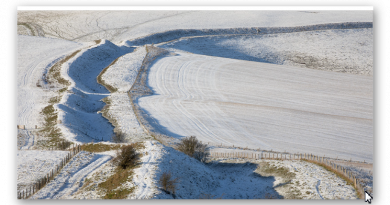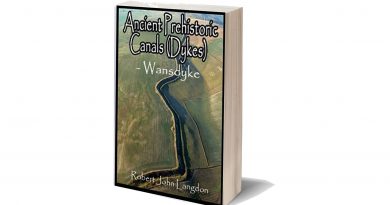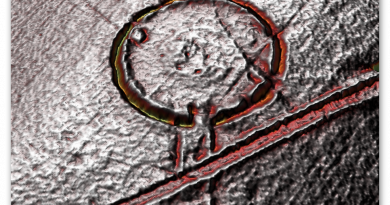Prehistoric Canals (Dykes) – Hadrian’s Wall Vallum (pt 1)
Promotional Video – Ancient Prehistoric Canals (Dykes) – The Vallum ( Hadrian’s Wall Vallum)
Extract From Book……………………… Ancient Prehistoric Canals (Dykes) – The Vallum
Traditional archaeologists and archaeological establishments like English Heritage suggest that:
The Vallum is a massive earthwork constructed shortly after Hadrian’s Wall itself and lying just south of it. Many visitors confuse the Vallum with Hadrian’s Wall itself because it’s such an obvious and impressive feature in the landscape.
In fact, the Vallum is made up of several different elements – a ditch around 6 metres wide and 3 metres deep; two mounds either side of the ditch about 6 metres wide and 2 metres high and set back from the ditch by around 9 metres; and often a third mound on the southern edge of the ditch. The whole complex is around 36 metres across. Usually, the Vallum runs close behind the Wall but in the rocky and hilly central section the Vallum lies up to 700 metres from the Wall.
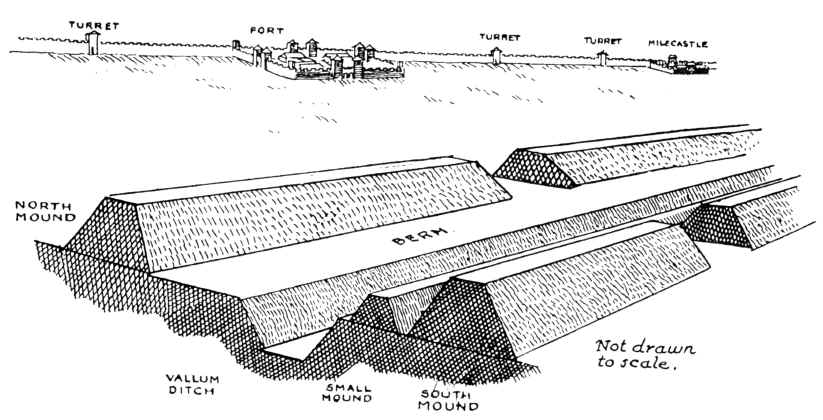
Crossing points seem to have been located south of each of the forts along Hadrian’s Wall and near several of the milecastles. Evidence from the excavated Vallum crossing at Benwell in Newcastle shows these crossing points had impressive monumental gateways.
The Vallum’s purpose is unclear. Many archaeologists think it marks the southern boundary of a military zone with the Wall itself forming the northern boundary. This would have helped protect the rear of the Wall and its associated military installations, with civilian access being closely controlled. The gateway at Benwell supports this idea. The numerous gateways along the Wall at forts and milecastles suggest that the frontier was intended as much to control movement as to provide a defensive line. Traders would have moved goods across the frontier but their movements would have been controlled and their goods taxed.
Relatively soon after it was constructed, some 20 to 30 years perhaps, the Vallum seems to have lost its function – the mounds were cut through and the ditch filled in at fairly regular intervals. It was out of use by the time the forts along the Wall were re-commissioned in the late second century AD following the return of the garrison from the Antonine Wall.

Sadly, these ideas that have been constructed over the last 200 years are somewhat questionable. Within the book we look at associated aspects of this area like Military Way which was supposed to be constructed to patrol the so-called ‘Military Zone’ – to find that:
That over 50% of Military Way does not exist as a separate road, as described by archaeologists. Instead, the perceived road is fragmented and only becomes ‘alive’ as an independent road when the Vallum separates from the wall at any distance.
This might give us a clue to the function of this rough and wonky road, as the stone for the wall would have needed to be delivered by cart if the Vallum canal was not available.
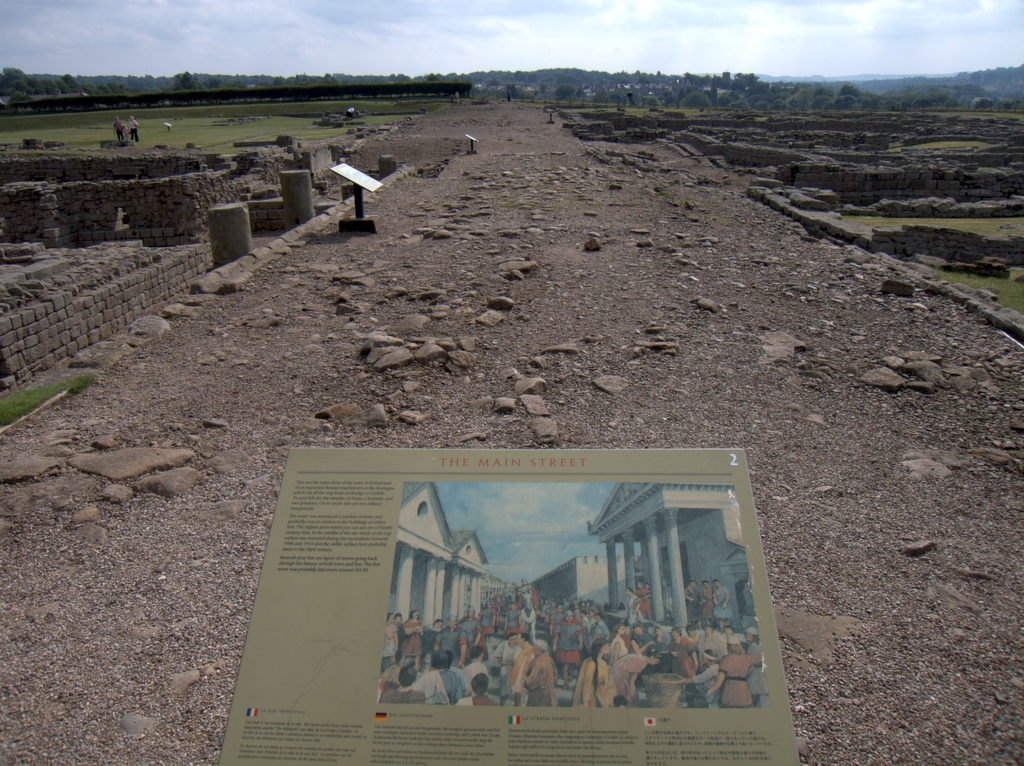
As for the Stanegate that was supposed to connect to the main forts in the area as a ‘defensive shield’ we actual found that it is very little to no evidence of the ‘Stanegate Roman Road’, which (according to the current theory proposed by English Heritage) ‘consolidated as a frontier’ during the late first and early second century AD and helped crystallise Roman tactics and military expectations in the area.
This evidence is compounded when you release that of the 80mile border from coast to coast – Stonegate, at best, covers just 38.1 miles (47%) of the ‘defensive gap’, and hence suggestions of extension over and above the existing line existed (even without support from OS maps). Moreover, the research has shown the ‘raw’ Stanegate road without the ‘hidden’ parts below the B-roads – we are only looking at 20% of the declared road being visible on LiDAR maps.
Stanegate Road (when not part of an existing B-road system) is inconsistent in width and structure -moving from bank track to road with two ditches on each side to a ditch with two banks far from straight and usually starts and ends in ravens.
Most Forts and the Stanegate are not found to connect (with intersecting sub-roads) on only two occasions, and the rest show no connection. Moreover, later ‘temporary’ camps also did not connect with the road – which questions whether (a defence line) was its purpose.
Moreover, this would then question the ‘myth’ of using the Stanegate as a ‘boundary’ for withdrawing troops from Scotland in the first century AD is correct. And whether the River Tyne (which most of these Forts sit upon) was used as a more practical and effective boundary/defence.
This ‘myth buster’ will not surprise many in academia as it has been ‘hinted’ at for some time (but not acted upon it by updating the literature), as we see from Symonds et al.
“The question of whether a road even existed when the fortlets were founded is by default an existential one for the notion that they provided highway protection. But even if the metalled road does post-date the fortlets, a reasonably robust thoroughfare of some form must have existed from at least the mid AD 80s to service Vindolanda. The question is not whether there was a road, but whether it was metalled when the fortlets were founded.” Symonds, M. (2017). Hadrian’s Wall. In Protecting the Roman Empire: Fortlets, Frontiers, and the Quest for Post-Conquest Security (pp. 95-132)
Moreover, even if Stanegate was not built as suggested, it exists in parts, and it looks prehistoric (by design) as it relies heavily on ravens that start and end sections of the Stanegate sections; its sunken structure in parts is unfamiliar to traditional Roman Road design.
As for other famous ‘Roman Features Such as the Great Chesters Aqueduct, again we find not only is the origin questionable but as it located supposedly fully in ‘hostile territory – they its usefulness win conflict would be limited.
It is clear from the LiDAR research that the suspected Roman Aqueduct is not as it seems. This is not the first examination to spread doubt about the scale and origin of this feature in the landscape – MacKay, D. A. (1990). The Great Chesters Aqueduct: A New Survey. Britannia, 21, 285–289. Also shows an incomplete map of this aqueduct.
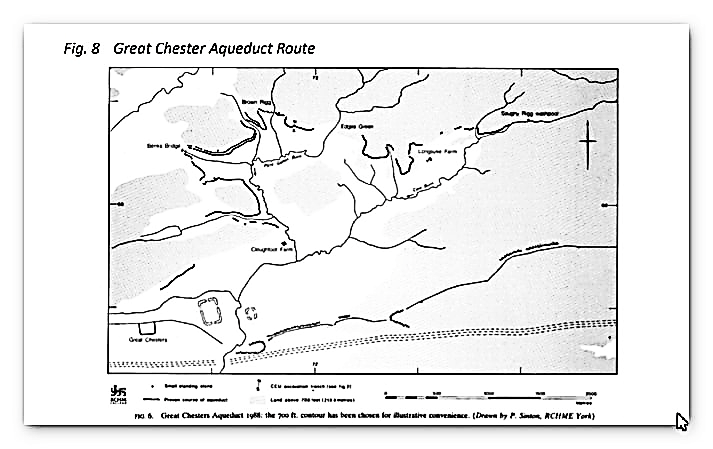
Mackey failed to find in their survey that the Aqueduct changed size, and the path suggested had no identifiable remains of the bridges required to make this Aqueduct work.
Our more detailed findings indicate that the topology of the aqueduct suggests that it would need to go uphill at several points without any powered assistance (like a siphon) and so is mechanically unsound. Our finding has found that the use of ‘Dykes’ in this area and some connecting to this Aqueduct feature is new. We have also shown that closer to the Fort it was supposed to supply, there were closed water sources which could be used and that the Fosse by the Wall was also a water supply.
We conclude that we found a prehistoric watercourse linked to their sophisticated ‘Dyke’ system. I would be bold to suggest that this was used for either agricultural purposes or maybe industrial, seeing the multiple sites of quarries associated and in the region of this feature.
Case Study – Stanegate Roman Road
Stanegate
According to Wikipedia:
The Stanegate (meaning “stone road”) was an important Roman road built in what is now northern England. It linked many forts, including two that guarded important river crossings: Corstopitum (Corbridge) on the Tyne in the East and Dere Street, and Luguvalium (Carlisle) on the River Eden in the west. The Stanegate ran through the natural gap formed by the valleys of the River Tyne in Northumberland and the River Irthing in Cumbria. It predated Hadrian’s Wall by several decades; the Wall would later follow a similar route, slightly to the north.
The Stanegate differed from most other Roman roads in that it often followed the most accessible gradients and so tended to weave around, whereas typical Roman roads follow a straight path, even if this sometimes involves having punishing slopes to climb.
A large section of the Stanegate is still used today as a modern minor road between Fourstones and Vindolanda in Northumberland.
It is believed that the Stanegate was probably built under the governorship of Agricola, from 77 to 85 AD, during the reigns of the emperors Vespasian, Titus and Domitian. It is also thought that it was built as a strategic road when the northern frontier was on the line of the Forth and Clyde.
An indication of this is that it was provided with forts at one-day marching intervals (14 Roman miles or modern 13 miles (21 km)), sufficient for a strategic non-frontier road. The forts at Vindolanda (Chesterholm) and Nether Denton have been shown to date from about the same time as Corstopitum and Luguvalium, in the 70s AD and 80s AD.
When the Romans decided to withdraw from Scotland in about 105 AD, the line of the Stanegate became the new frontier, and it became necessary to provide forts at half-day marching intervals. Newbrough, Magnis (Carvoran), and Brampton Old Church were additional forts. It has been suggested that a series of smaller forts were built in between the ‘half-day-march’ forts (6.5m/10km). Haltwhistle Burn and Throp might be such forts, but there is insufficient evidence to confirm a series of such fortlets.
Pretty straight forward you would imagine – so where is the problem you might ask?
According to English Heritage
The Stanegate Military Roman Road linked Corbridge and Carlisle, which were also situated on important north-south routeways. It also extended west of Carlisle towards the Cumbrian coast.
The construction of a series of forts along the road line allowed many troops to be stationed in this crucial frontier area and ensured that the site could be extensively patrolled. A series of smaller watchtowers were also built to help frontier control. The Stanegate frontier thus created, developed further, and consolidated during the late first and early second century AD and helped crystallise Roman tactics and military expectations in the area.
The function of the road and its forts changed when Hadrian’s Wall was constructed to the north, and their support roles were, initially at least, enhanced. The later history of the road and its forts and their relationship with the Wall is less well understood, although, overall, their strategic functions declined as the new frontier line was confirmed.
Therefore!
Stanegate is built from Corstopitum (Corbridge) to Luguvalium (Carlisle) a distance of 13 miles constructed between 77 to 85 AD so it predates Hadrian’s Wall, but it’s not like most Roman Roads as it’s not straight and follows the contours of the landscape. Moreover, when the Romans withdrew from Scotland in 105 AD (Hadrian’s Wall was built in 122 AD), it was used as a frontier line.
But is it true?
Let’s look at the suggested route and find out using LiDAR if it is remotely true.
For Ease’s purpose, we will go from West to East for reasons that will become obvious at the end of the case study.
Route (according to English Heritage)
The Stanegate began east at Corstopitum, where the critical road, Dere Street, headed towards Scotland. West of Corstopitum, the Stanegate crossed the Cor Burn and followed the north bank of the Tyne until it reached the North Tyne near the village of Wall. A Roman bridge must have taken the road across the North Tyne, from where it headed west past the present village of Fourstones to Newbrough, where the first fort is situated, 7 miles (12.1 km) from Corbridge and 6 miles (9.7 km) from Vindolanda. It is a small fort occupying less than an acre and is in the graveyard of Newbrough church, which stands alone to the west of the village.
From Newbrough, the Stanegate proceeds west, parallel to the South Tyne, until it meets the next major fort, at Vindolanda (Chesterholm). From Vindolanda, the Stanegate crosses the route of the present-day Military Road and passes just south of the minor fort of Haltwhistle Burn. From Haltwhistle Burn, the Stanegate continues west away from the course of the South Tyne and passes the major fort of Magnis (Carvoran), 6 miles (10.5 km) from Vindolanda and 20 miles (32 km) from Corstopitum. The road is joined by the Maiden Way coming from Epiacum (Whitley Castle) to the south.
From Magnis, the road turns towards the southwest to follow the course of the River Irthing, passing the minor fort of Throp, and arriving at the major fort of Nether Denton, 4 miles (7.2 km) from Magnis and 24 miles (39.4 km) from Corstopitum. The fort occupies an area of about 3 acres (12,000 m2).
From Nether Denton, the road continues to follow the River Irthing and heads towards present-day Brampton. It passes the minor fort of Castle Hill Boothby and then, 1 mile (1.6 km) west of Brampton, reaches the next major fort, that of Brampton Old Church, 6 miles (9.7 km) from Nether Denton and 30miles (49.1 km) from Corstopitum. The fort is so-called because half of it is buried under Old St Martin’s church and its graveyard.
From Brampton Old Church, the road crosses the River Irthing, continues southwest through Irthington and passes through what is now the site of Carlisle Airport, just to the north of the main runway. The curving corner of an associated marching camp can be made out from the air on the south edge of the runway near its western end and seen on Google Earth. The Stanegate then continued through an extensive cutting in High Crosby, where a small fort was postulated based on marching distances but was not yet found.
The Stanegate then crossed the River Eden near the cricket ground in modern Carlisle and eventually reached the fort of Luguvalium (Carlisle) on the site of Carlisle Castle, 7 miles (12.1 km) from Brampton Old Church and 38 miles (61 km) from Corstopitum. It has been suggested that the road may have carried west for a further 4 miles (7.2 km) to the Roman fort at Kirkbride overlooking Moricambe Bay, an inlet of the Solway Firth. A large camp of 5 acres (20,000 m2) was found there, but the evidence for a road is insufficient.
It has also been suggested that the Stanegate may have run eastwards from Corstopitum towards Pons Aelius, present-day Newcastle upon Tyne, possibly linking to Washing Wells Roman Fort in Whickham, but no evidence has yet been found to support this.
Notice that not only they are not in a straight line, but they are gaps in the location of the forts as this so called 6.5-mile marching gap rule is inconstant or in some cases non-existent as evidence has yet to be archaeologically found.
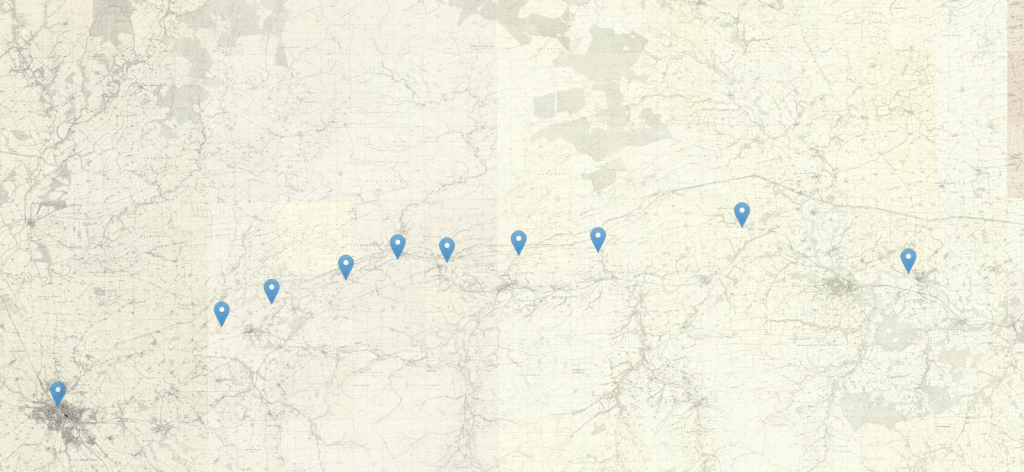
Here is what LiDAR makes of this road:
Carlisle to Brompton Section (7.8 miles/12.5 km – Direct)
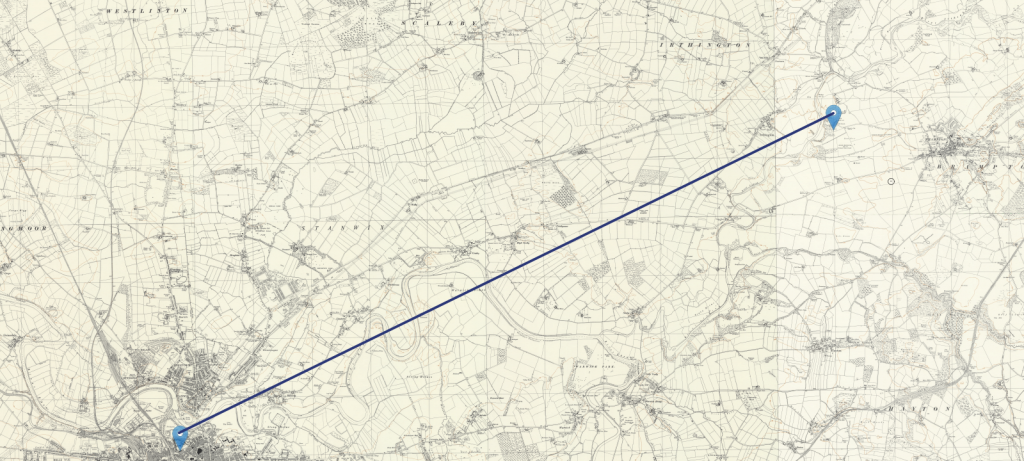
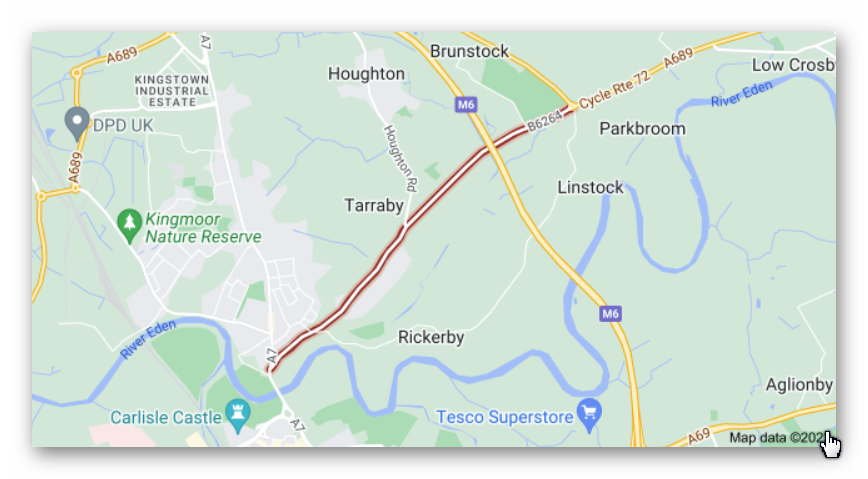
The most obvious route from Carlisle Castle (Luguvalium Roman Fort) to Brompton Fort is the B4245, which may have been originally the old ‘Stanegate road’, which heads for Brampton Old Church via Irthington.
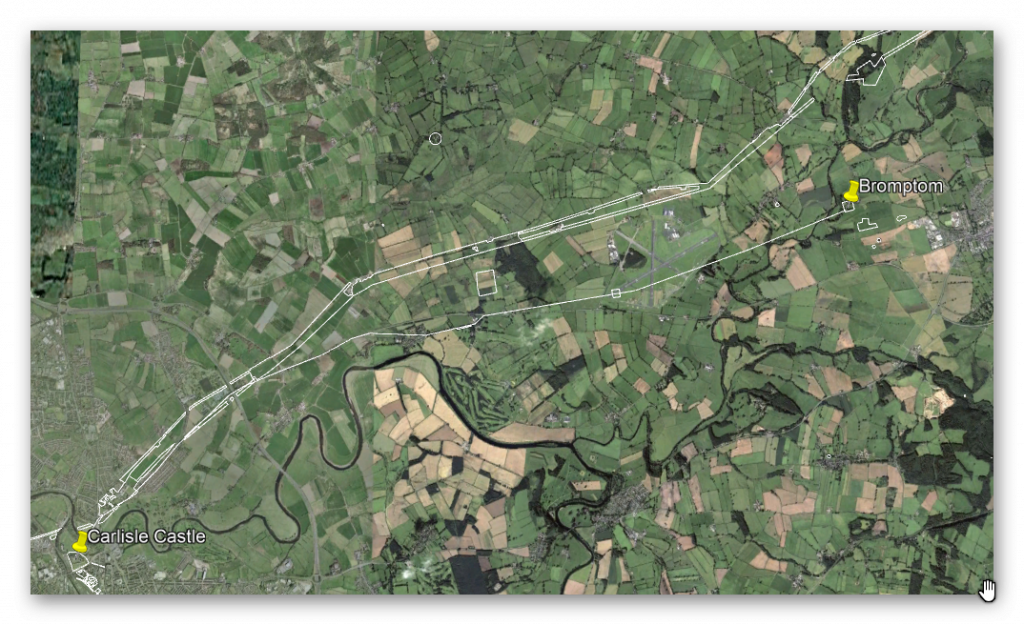
One would imagine that you would stay on this bendy road until you get to Brompton – but the OS maps show that Stanegate veers off it at High Crosby?
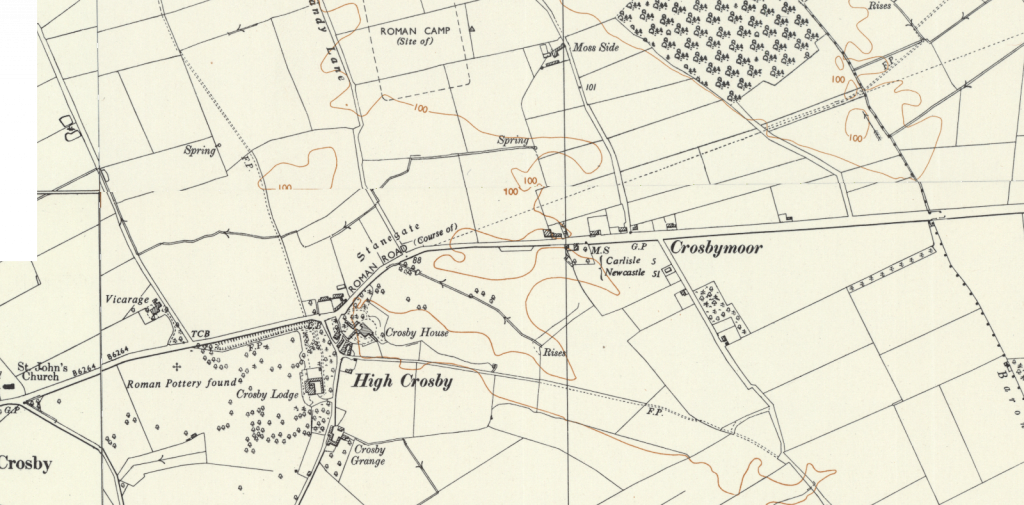
The problem is that (although the road has been supposedly spotted on Google Earth – LiDAR shows absolutely nothing.
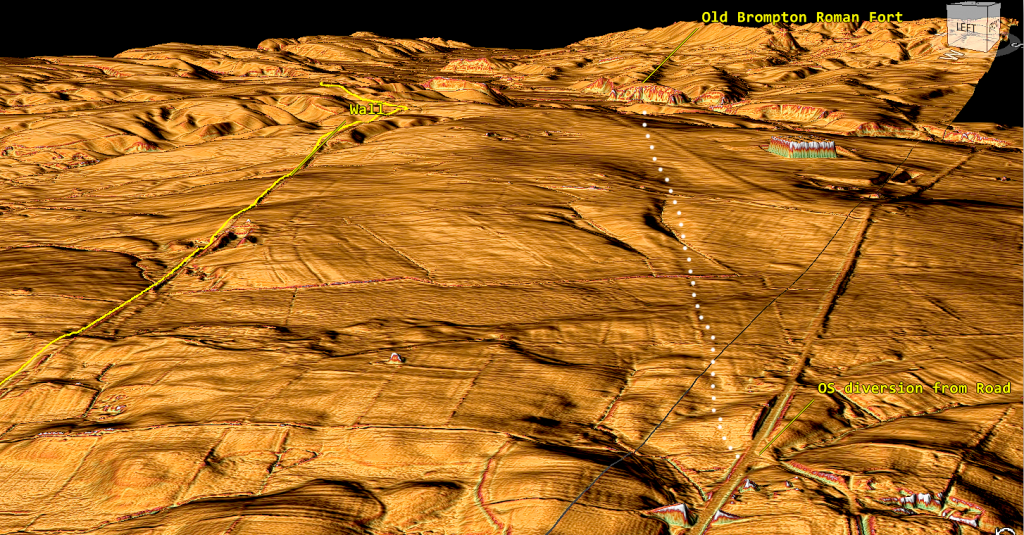
The line of the road (which goes through Carlisle airport) abruptly ends at a massive riven by the river Irthing. The fort has no direct road access (even if you continued on the B4245, there is no turn-off) until you reach Brompton, and then it’s a windy 1.5 mile / 2.4 km road (old church road). So, to supply this station, you will need a boat and its position on the river.
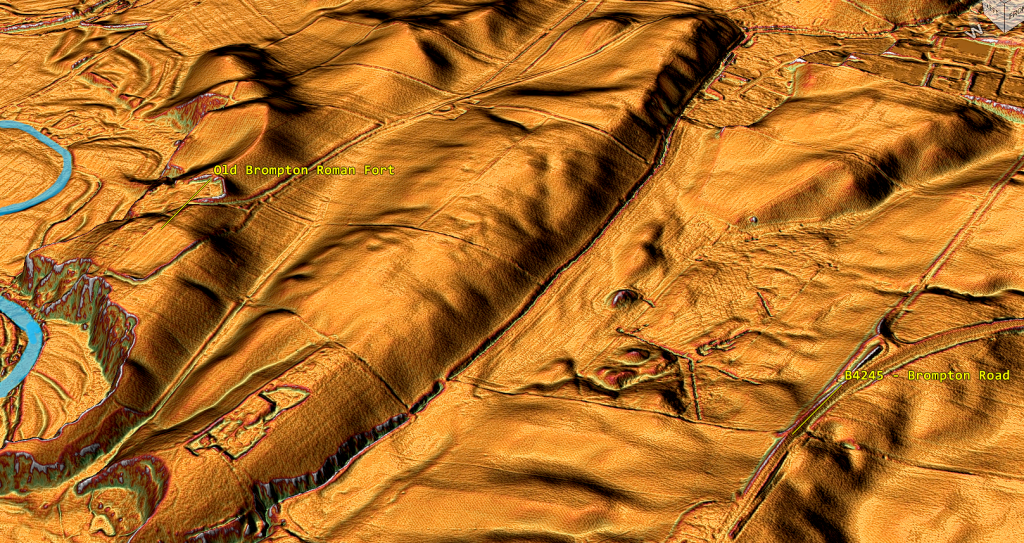
Brompton To Boothby Fortlet (2.4 miles / 3.8 km)
We can find no road on the OS maps that connects the two forts or any other scheduled monument. Likewise, there is nothing on the LiDAR map, and although Boothby Fort appears on Historic England’s listing as a scheduled monument on LiDAR, there is absolutely nothing or any road connection.
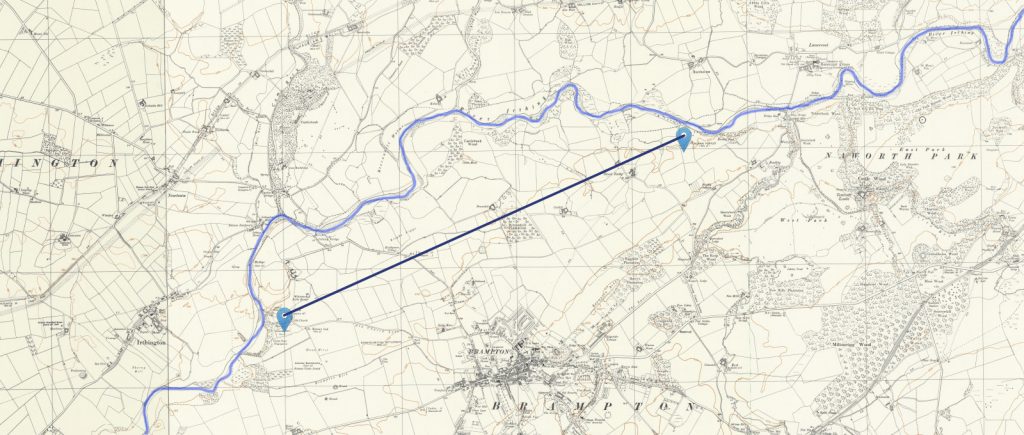
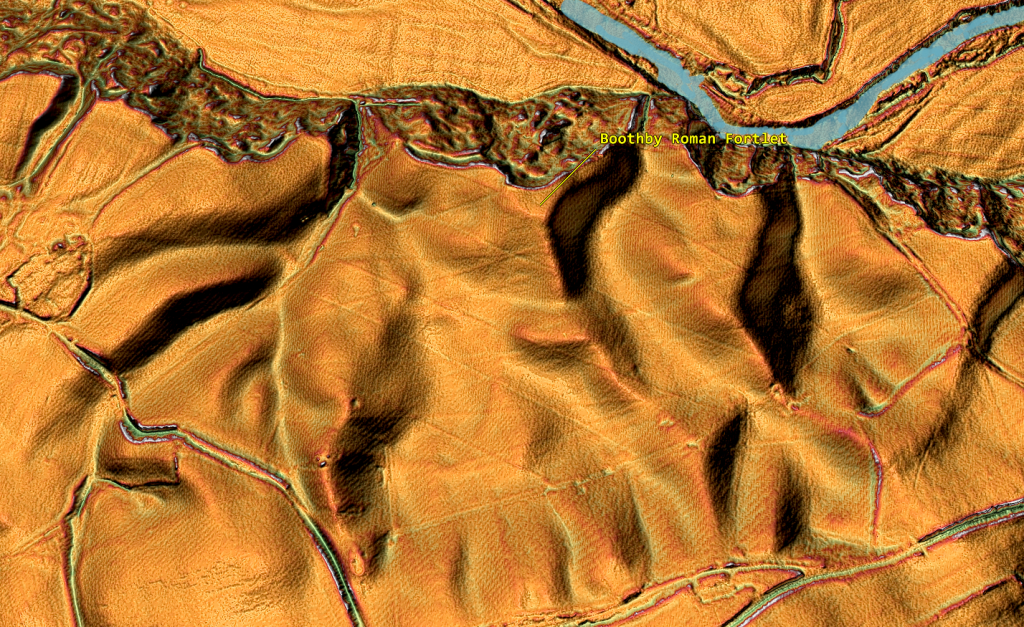
The only possibility is that the Roman Fortlet slipped into the old riverbed – this would suggest that the river must have been much more prominent and higher in the past.
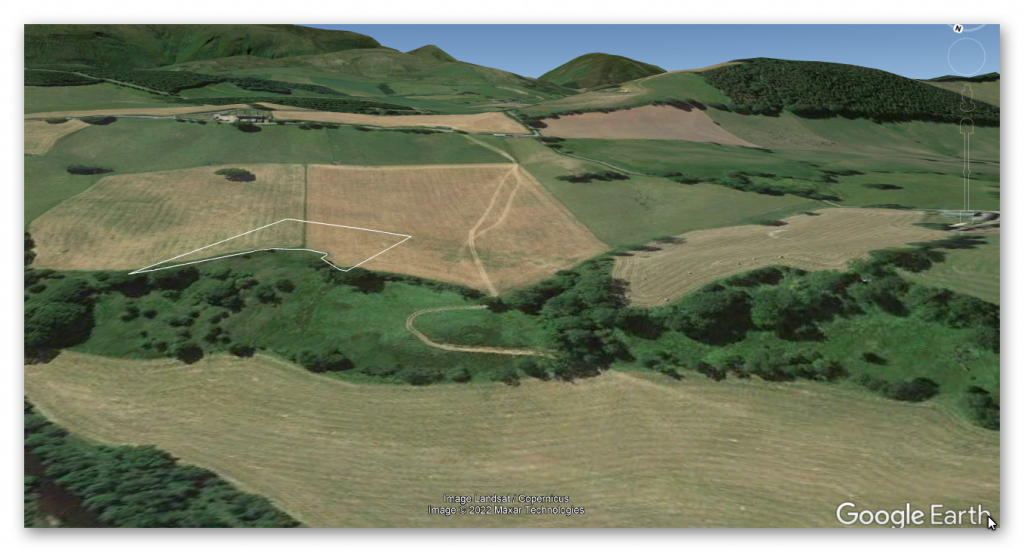
This would question if the site was Roman or Prehistoric as it has only been identified by air photos and a single excavation of a ditch in the past. However, we have identified possible Dyke/Paleo channels in this area, and so it is possible that one of these Dyke/Paleo channels was recognised in the 1947 air photographs as the side of the Roman Fort, and in fact, the Dyke was partially excavated?
If we return to our LiDAR map of the area and flood it with a higher water table (10m over the current river level), we not only see why Boothby slid into the water (if it was a Roman Fort) but moreover, was also see why Old Brompton Roman Fort was so isolated with no adjoining roads.
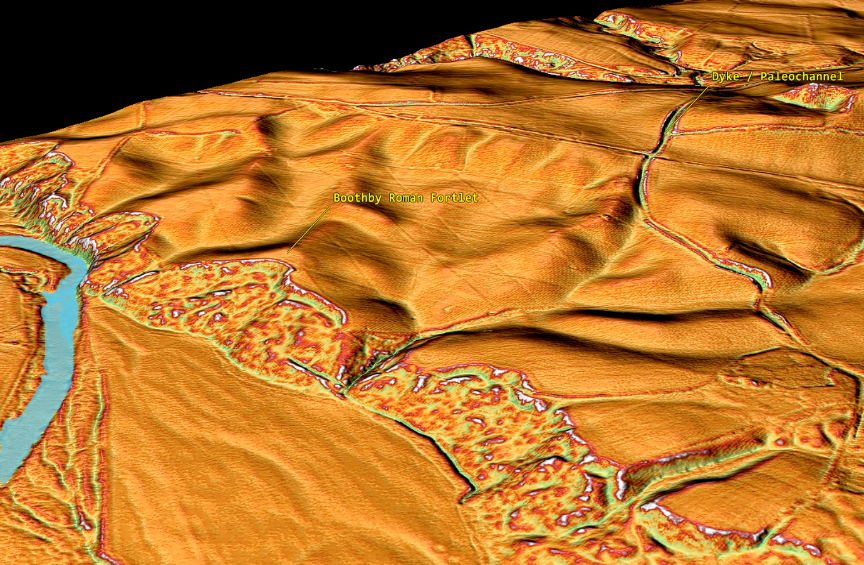
So what’s going on here?
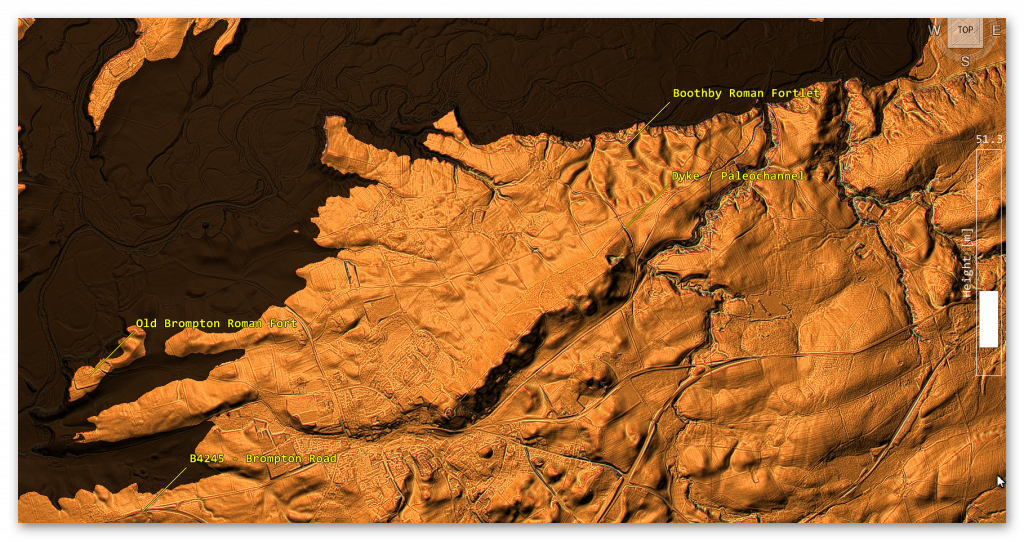
We have failed to find Stanegate road (if the OS map is correct), and neither of the Roman Forts has any road connection to the Stanegate – even if the current Old Brompton Road is the real Stanegate.
Boothby to Nether Denton Roman Fort (3.4 miles / 5.4 km)
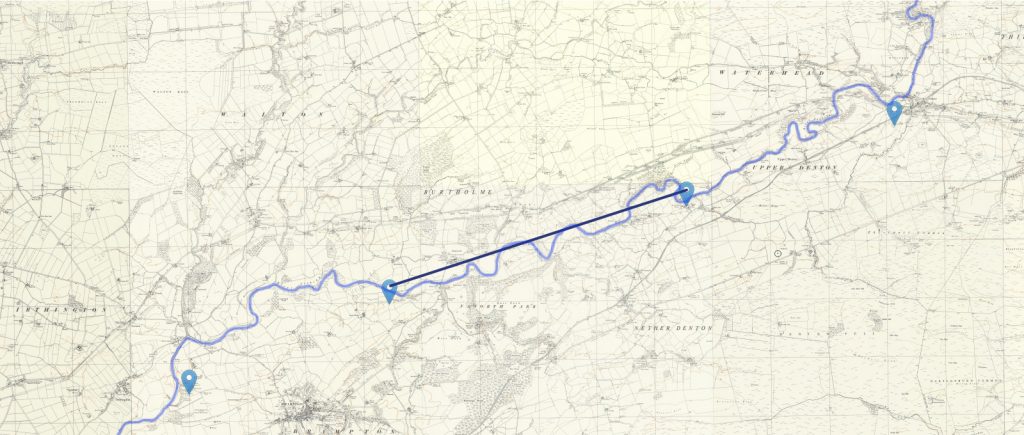
Again there is no road (modern or old that connects the Nether Denton Fort to Boothby) – the only connection is the river, and it is this river that archaeologists are now suggesting was the ‘natural’ boundary when the Romans retreated from Scotland in 105AD before Hadrian’s Wall was constructed. (Symonds, 2017). The pathway to the south of the Fort stops at the river.
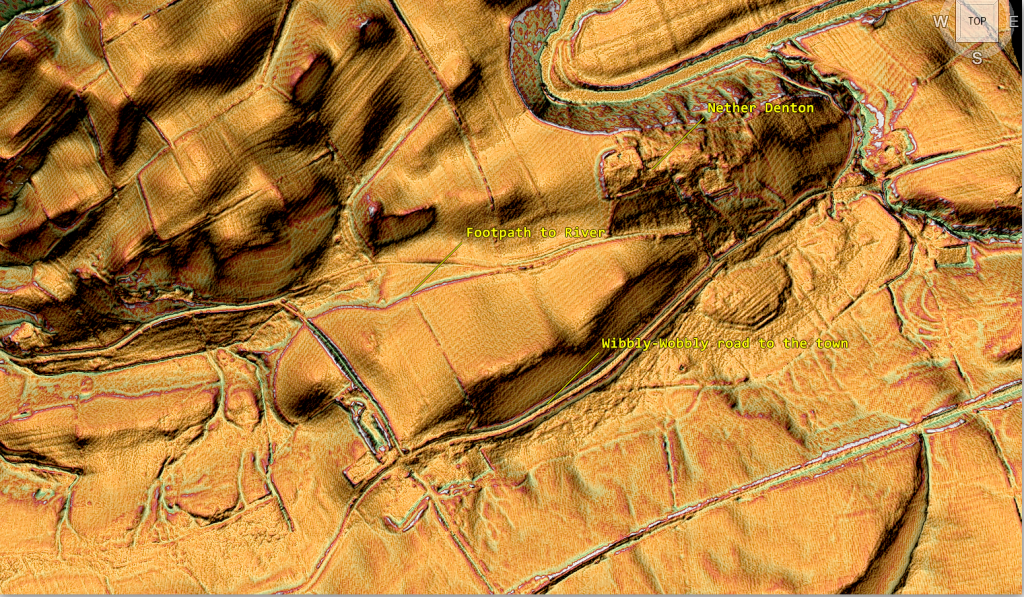
The first 5 Roman forts on the ‘Stanegate road’ are on the river irthing and not connected by a single road!!
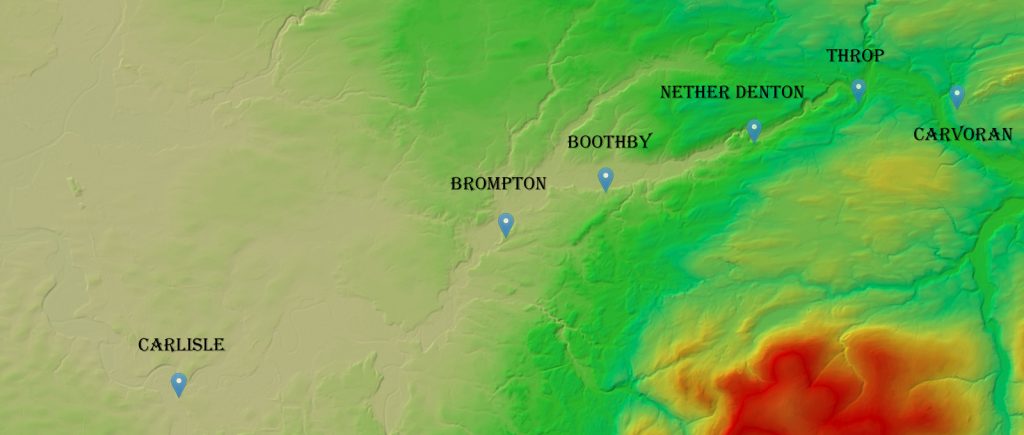
So where is Stanegate, and did it ever connect any Roman forts?
There is no road connection; consequently, they are all connected by the river.
Nether Denton Roman Fort to Throp (2.3 miles / 3.8 km)
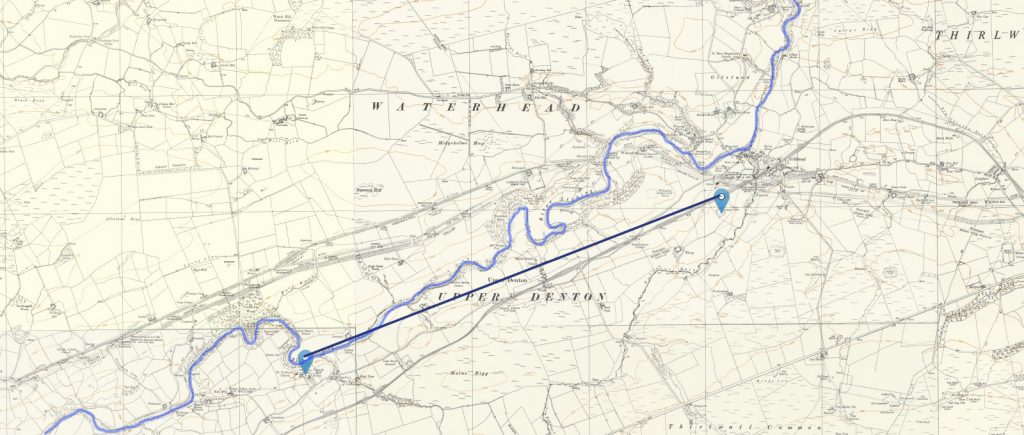
The first signs of the old Stanegate Road on OS maps (not associated with current roads) appear as we move towards the fourth fort, ‘Throp’- further down the river.

This road is not very well defined in the landscape, with a single ditch (8m) on the North side rather than two ditches on either side. The road is 9m wide, then halves to 4m wide in places.

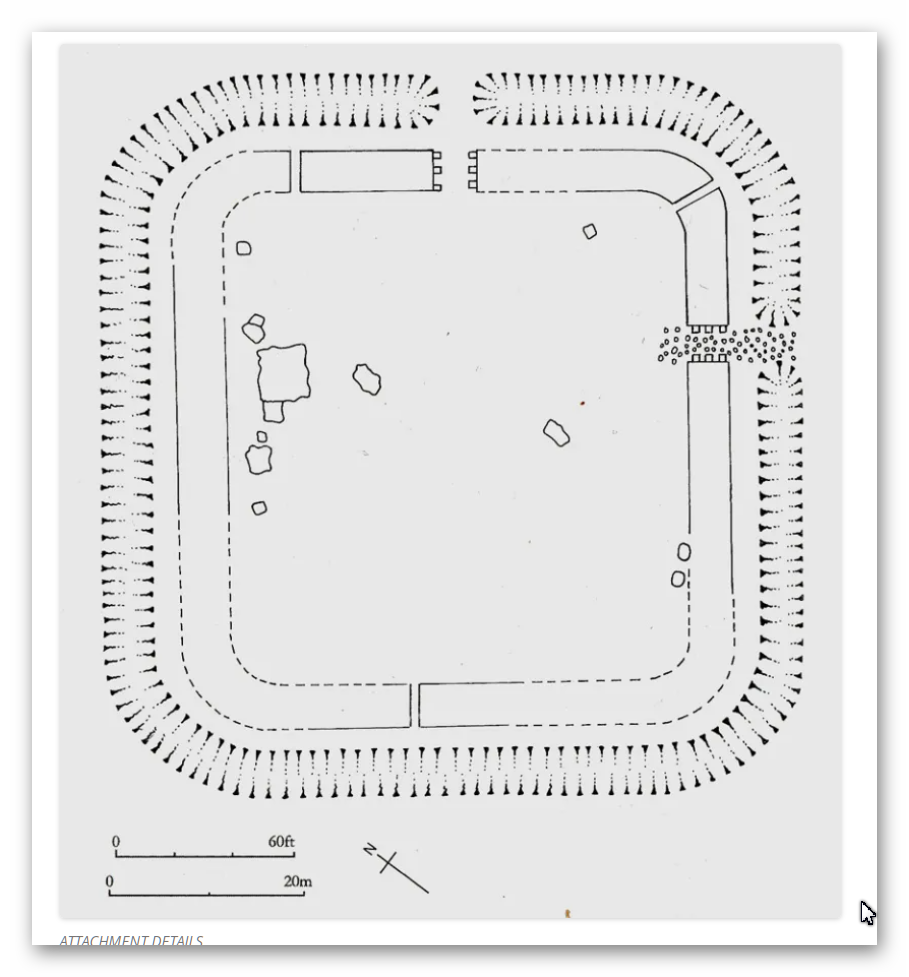
According to the archaeologists, this camp’s exit is obvious (South East).
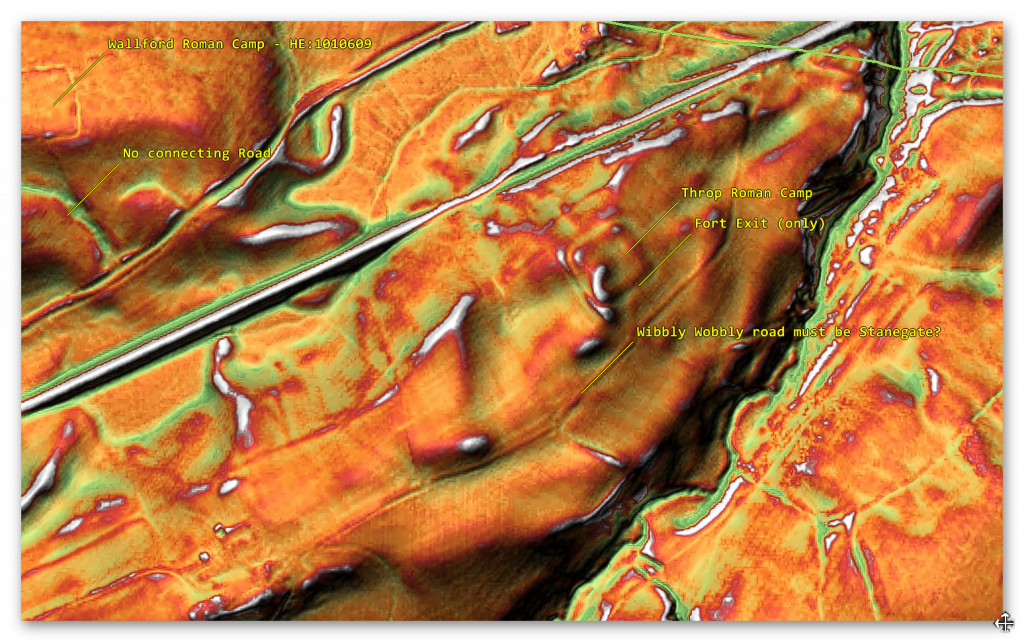
If Throp Fort does indeed join Stanegate – then the road is very ‘wibbly wobbly’ in construction and veers North East past Throp Fort and into a riven where it disappears by the Vallum (green line), which also seems to have gone missing.
We also see other Roman camps like Wallford (like the last four Roman sites we have studied) that are next to the River Irthing – but again not connecting to the Stanegate – although the road is only a few hundred metres from the site; according to the OS maps? Moreover, there are more substantial (sized) than Throp; Wallford (626m to the NW) and Crooks (600m to the SE); therefore, has it been misidentified as one of these critical sites of defence??
Consequently, if it was a fallback position and using the River as the border, it was too far away from the River to be effective; therefore, would Wallford (which is on the water) be the preferred fort?
Throp to Carvoran (2.1 miles/3.4 km)
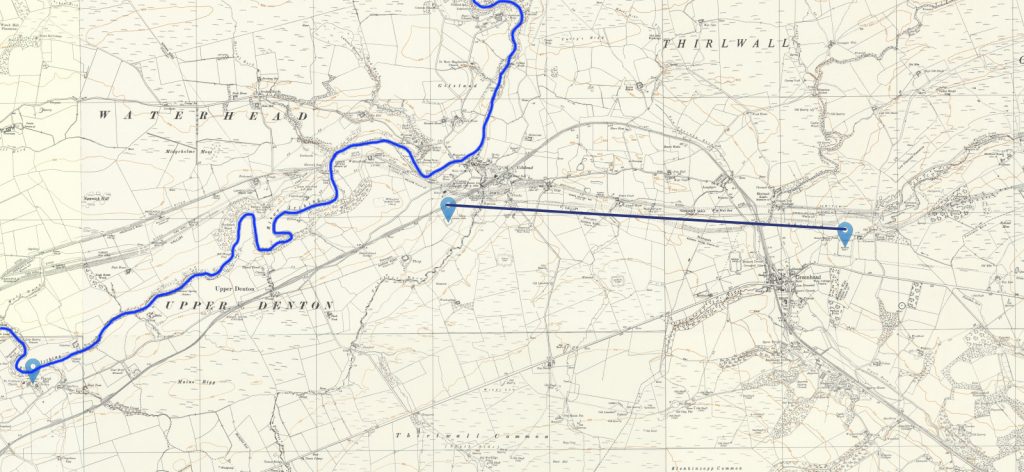
The Stanegate Road that goes to Carvoran from Throp seems to start suddenly at the top of the hill in the region of a quarry – there is no sign of any road in or coming out of the riven where Trop exists. Interestingly, The Vallum (which is next to and parallel to Stanegate seems to do the same – indicating this area may have been flooded in the past and during the Roman period.
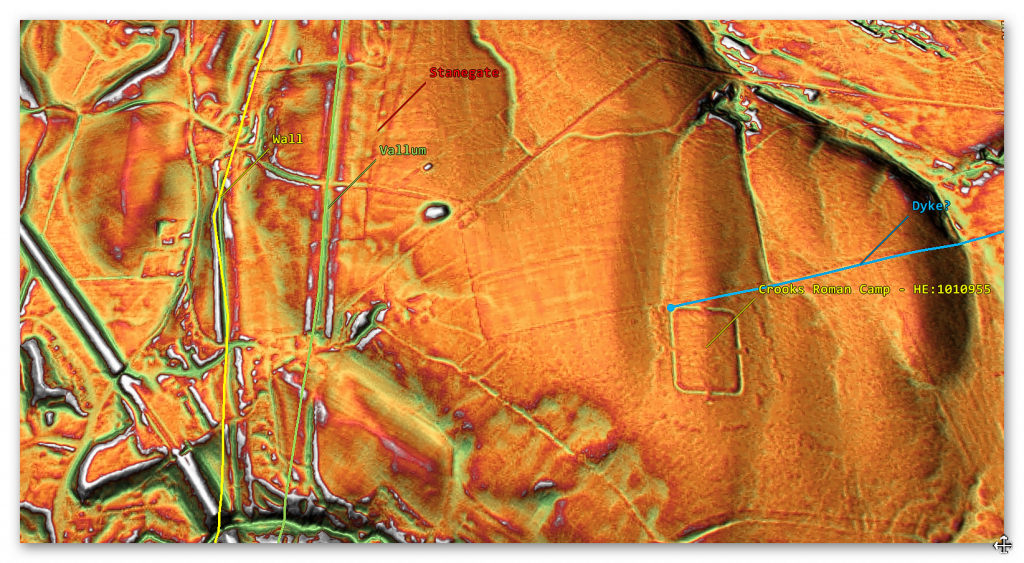
This observation is reinforced by the Roman camp of Crooks which has no road connections but seems to be connected to a Dyke as it has a double bank on each side of the straight track – which starts in a nearby river valley and ends in the same valley as Stanegate starts?
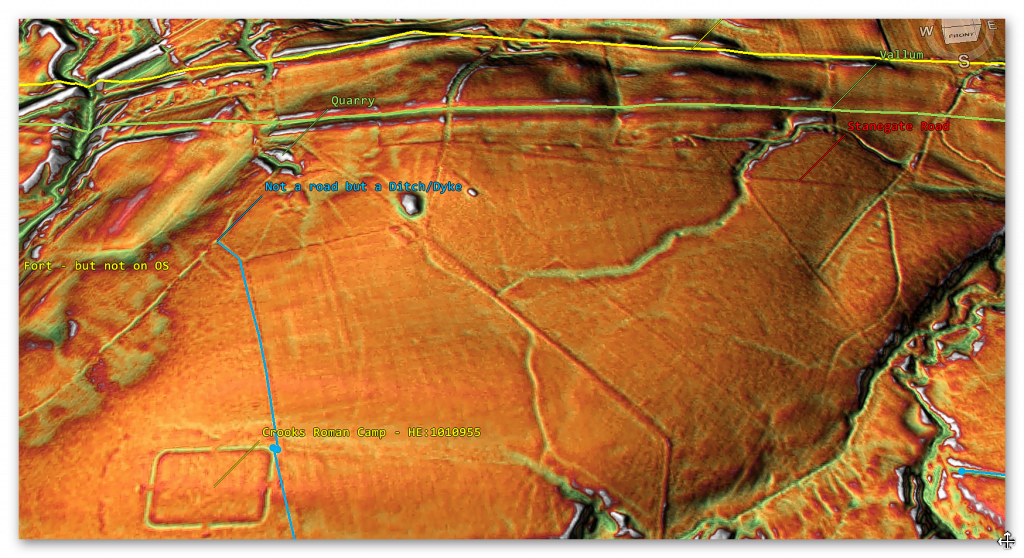
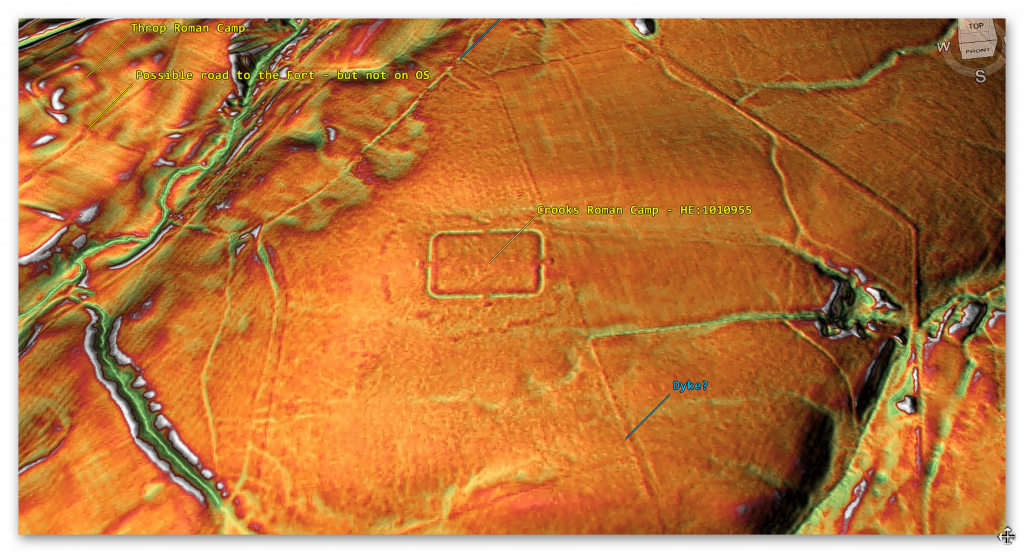
But a clear connection to the Fort is not conclusive as the road/dyke is at a strange angle, and one would imagine that if the trackway existed at the time of construction – the fort would be built to the exact alignment rather than aligning with the two river valleys in the area?
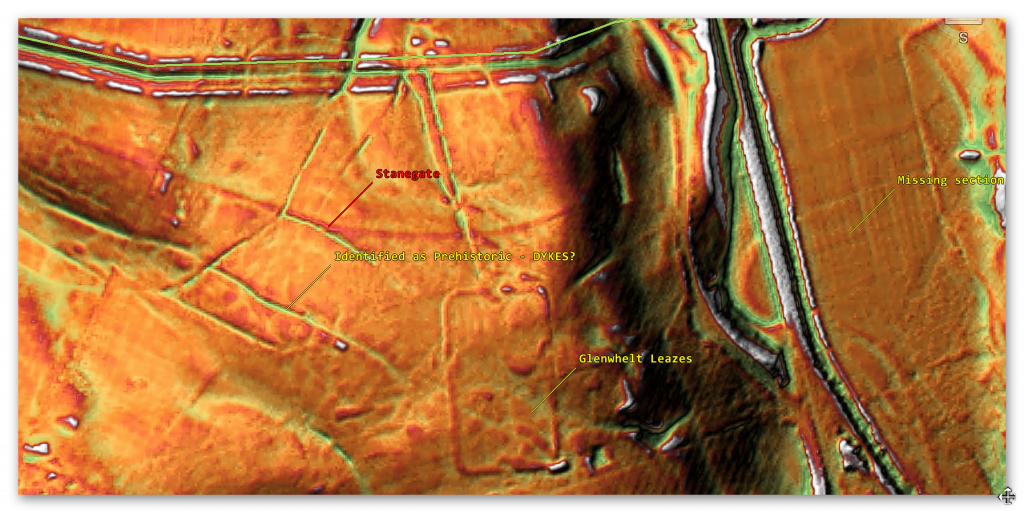
Further down the observable road, we find a Roman Fort that connects to this section of Stanegate – Glenwhelt Leases.
There seems to be a direct connection to Stanegate via a sunken path. This path continues to the Vallum, passing Stanegate – an Historic England Report ‘Haltwhistle Golf Course, Greenhead Carlisle; Glenwhelt Leazes Temporary Camp: Aerial Assessment by Cara Pearce – suggest that the ditches to the WEST of the site are prehistoric in origin (which strangely look like the same size and shape as the ditch going North)?
There is no evidence of Stangate or the road going down the slope to the river or crossing this riven (needs a bridge?), and OS maps show it disappears and reappears just before Carvoran camp.
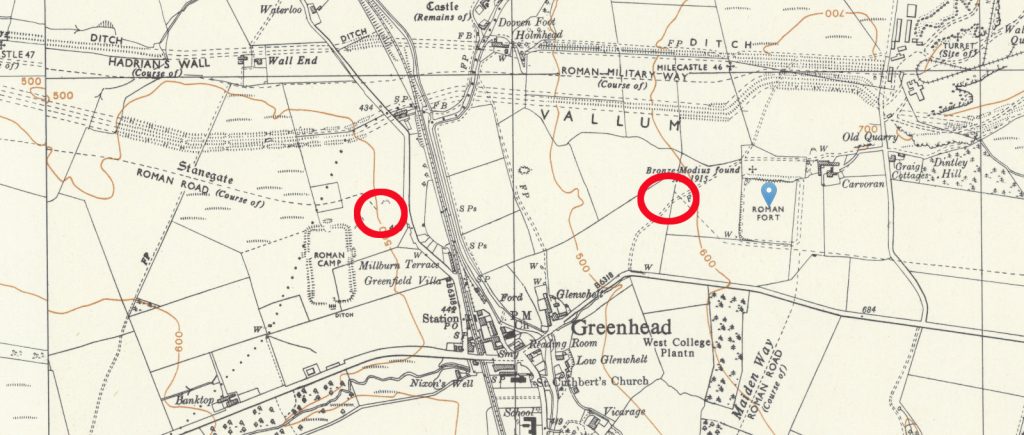
On the other side of the riven is Carvoran Roman Fort. The OS map suggests a SE Stanegate meets the Southern aspect of the Fort and then continues east parallel to the fort’s wall until it meets another Roman Road called Maiden Way – sadly, LiDAR proves this is pure speculation!!
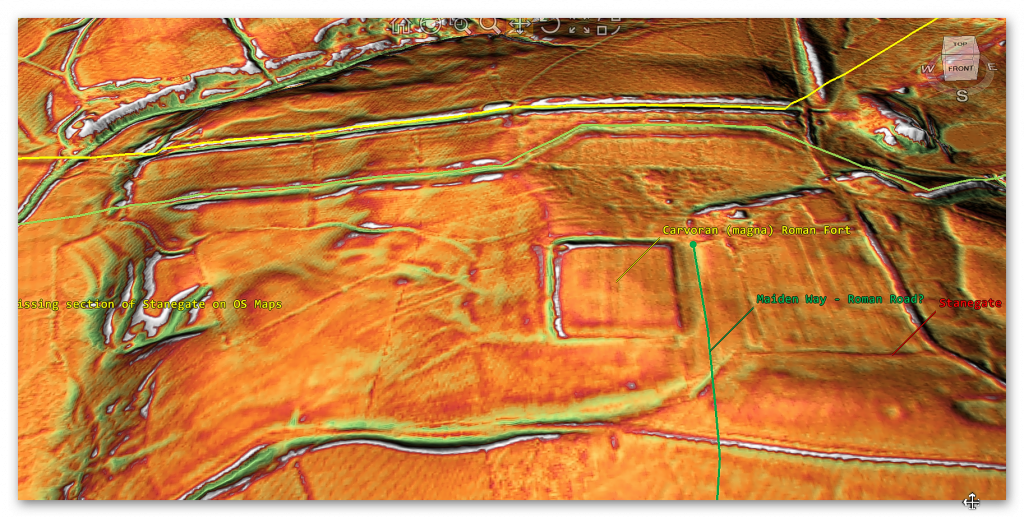
The interesting aspects of Carvoran (somethings known as ‘Magna’) are that it does not connect to Stanegate or Maiden Way. The only raised walkway is in the NW of the camp and links to the Vallum (again) – as you will see in other case studies, the Vallum (spoiler alert!!) was also used as a roadway
From the LiDAR map, Stanegate appears from out of the riven and via a present-day roadway sunk into the ground (so it could have been another Dyke originally) whose bank was used as a road, and the Stanegate piggy-backed onto this prehistoric route?
Carvoran (Magna) to Haltwhistle (3.1 miles / 5km)
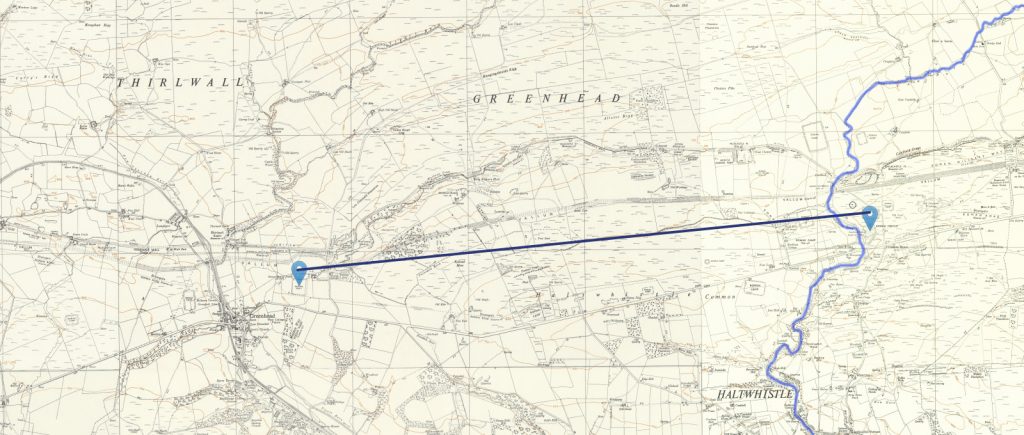
This is the first stretch of Stanegate that is complete and connects two of the supposed defensive forts made for the Stanegate together!!
On this road to Haltwhistle, we notice Stanegate changes character several times.
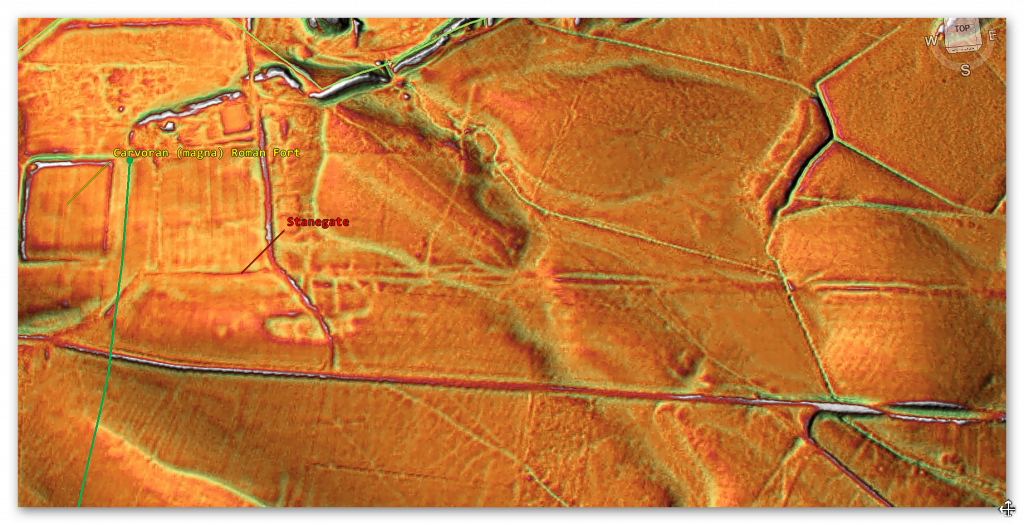
At the start of the road in this section, it is 4m wide with no gutter on each side – but as we reported earlier, “Where it left the base of Corstopitum, the Stanegate was 22 feet (6.7 m) wide with covered stone gutters and a foundation of 6-inch (150 mm) cobbles with 10 inches (250 mm) of gravel on top.” So we are looking at a 7m road that fits the classic description.
So, this section is nearly half the expected size?
A few hundred metres East of this point, the Stanegate turns into a 24m wide road with an 8m central roadway and 8m ditches on both sides – before disappearing into quarries. And these quarries are commonplace on this road – which we will look at more in the essay’s conclusion. Then Stanegate emerges into a broken, dysfunctional construction of no obvious nature.
And so when it crosses a modern suspected Roman Road, we see no kind of intersection and barely a trace of Stanegate.


Stonegate returns to its single track just before it reaches Haltwhistle Fort and once again turns into a ditch with two banks, then disappear down ‘Haltwhistle Burn’, returning as a ditch with two banks (20m wide) or could be judged as a Bank with two ditches 23m wide with ditches the same size as the Fort.

The fort itself is also interesting as the design is a fort within a fort – archaeologists have suggested it was designed this way:
“Nevertheless, it seems convincing and matches the presence of storage facilities in some larger road fortlets elsewhere, such as Castleshaw (Bidwell and Hodgson Reference Bidwell and Hodgson2009, 73). The articulation of the Stanegate fortlet gates makes sense to allow traffic loading or offloading goods to circulate easily through the installation. Building a measure to aid traffic flow into the design implies that this was a fundamental concern, suggesting a logistical role for the fortlets, rather than frontier control.”
This idea of storage we again will come back to within the conclusion.
Haltwhistle to Vindolanda (3.4 miles – 5.5)

The Stanegate Road to Vindolanda is of great interest as it goes past a vast number of Quarries and Forts, including Haltwhistle Tep camps 2 & 3, which again have no road connection to Stanegate Milestone House, Seatsides 1 & 2 Temp Camp, bean Burn 1 & 2 and a massive 15 Quarries.

This Milestone House can’t be a defensive fort as it is too large and on the eastern side unprotected – moreover, it’s covered in Quarries, and EH also reports kilns in its interior.
So, this was a protected industrial area, and the other Temporary camps were probably also storage areas for their mining operations. Interestingly, as the boundary of the fort goes over the existing B-road, we can conclude that at the time of construction (the fort), the Stanegate was the only road, but the fort boundary falls short of the road on both East and West sides.

When we finally reach Vindolanda, the OS maps suggest that Stanegae separates from the existing road and bypasses (no doubt with the view of it connecting to the fort), then moves across the valley to move NE to the next fort.
Sadly, this is not the case, and the fort doesn’t seem to connect to either Stanegate or the current B-road.


The most up-to-date map (from the new Charitable trust) shows the road coming out NW and joining the new road (no sign of Stanegate on this map?)
Vindolanda to Newbrough (6.2 miles / 10 km)

Stanegate becomes an existing road at an interesting junction. The OS map shows the Stanegate coming out of the riven of Vindolanda but is not on the LiDAR map.

Stanegate seems to come out of a steep gradient from the raven (like a Dyke) and head towards a quarry. Then it starts again on the other side of the quarry ‘under’ the existing B-road.

This B-road has had a Roman milestone found (in the 19th century) by the wayside that travels to Newbrough, passing numerous quarries and two other Roman temp forts again without clear road connections.


The ‘experts’ are confused by the site:
“Newbrough Roman Fort was 195ft north-south and190ft east-west. This is about 0.75 acres sufficient to house two centuries, say 160 infantry. The stone walls were surrounded by a ditch 15ft wide and 5ft deep, 16ft from the walls, which were 4ft wide. It was identified as the 4th century by coins, pottery and construction. Why it was built here close to Hadrian’s Wall is a mystery. It was only excavated once in 1930.
At the beginning of the 2nd century, the Stanegate had become the defacto frontier just before Hadrian’s Wall was built.
The location indicates that should have been an earlier fort here at the beginning of the 2nd century, but nothing was found at that time.”
Is it as if there was a massive gap in the Stanegate Road theory and needs something to fill it?
Newbrough to Corbridge (7.4 Miles / 11.8 km)

Once Stanegate leaves Newbrough town on the existing B-road, the OS maps show it veers off NE into nowhere. This seems to be because they have found a piece of ‘Roman Road’ by another quarry (about a mile from the turn-off), and archaeologists have imagined it to be Stanegate – the LiDAR map shows that this route does not exist in reality, but only this tiny (220m) roadway.

Stanegate disappears towards the River Tyne – in theory, it is supposed to cross the river (via a bridge) and then head south to Corbridge.

We see a wibbly-wobbly ditch and bank – which is probably a Dyke – certainly not a bridge and no signs of a road down the bank of the Tyne unless the railway built it on top of Stanegate – but why would you follow the river doubling the mileage when you construct a direct road across the land, and the railway ends only halfway at Acomb, not Corbridge!
Moreover, if we attempt to trace this road from Corbridge to where we left it outside Newbrough, we find that the OS map shows no trace (apart from a Roman road heading for the Roman baths that disappear into yet another Burn?

In all honestly, this is such a loose connection – its beyond comprehension and the reason we started our investigation from the West to the East as the suggestion:
“The Stanegate began in the east at Corstopitum, where the important road, Dere Street, headed towards Scotland. West of Corstopitum, the Stanegate crossed the Cor Burn, and then followed the north bank of the Tyne until it reached the North Tyne near the village of Wall. A Roman bridge must have taken the road across the North Tyne, from where it headed west past the present village of Fourstones to Newbrough.”
Excavations
We would have hoped that some of these questions raised in our investigations would be resolved through excavating various parts of the ‘Stanegate’. But, sadly, the number of studies are small – so small we can find only one outside the Roman forts.
This was not a full proper investigation but a transport investigation on roadworks on the Settingstones B-Road on which Stanegate was supposed to have been laid upon. The pictures clearly show something was laid down before the current tarmac – but is it Stanegate or the Victorian foundation work?
The pictures don’t tell us much, and the bewildering fact that once found, no full investigation to see the extent and construction structure was not actioned – illustrates the ‘state’ of archaeology today. Could you imagine if this two-thousand-year-old road was found in the USA? Would they have just dug through it, laid the pipework, and then reinstated it and go away???
With this disregard for history, we may never find out the truth, as by the time we realise the problem – the evidence (like most of the Wall, Vallum and associated Roads) will be destroyed or ploughed out.


If it is the Stanegate – is the construction non-standard and therefore questionable?

Stanegate in Forts
According to the Historic England records, the only other excavation was done by Simpson in his publication ‘Excavations on the line of the Roman Wall in Cumberland during the years 1909-12’.
If you read this ‘undetailed’ analysis, you will become aware of the history and speculation of this road.
“Stanegate is a Roman road in Northumberland which runs south of the Valium from Carvoran through Chesterholm to a point near the meeting of the North and the South Tyne, and which probably . . . extended as far as the Roman fort at Chesters, or that at Corbridge”
“In a footnote, the finding of a milestone at Crindle-dykes, bearing the mileage MP XIIII, is recorded. The spot where this stone was found is just fourteen Roman-miles from the site of the Roman fort at Corbridge and . . we may perhaps incline to the view that the Stanegate went to CORSTOPITUM.”
“Since the time of Horsley it has been supposed that this road, was continued into Cumberland. Horsley himself thought that it ran more probably from Castlesteads than Carvoran, and formed only a straight cut from Castlesteads by Irthington and the Watchclose ” camp ” to Stanwix (Britannia, p. 144). Others-have traced it from Carvoran to Gilsland, Denton, Naworth Park, the Roman ” camp ” at Hawkhirst, Watchclose, and so into Carlisle.”
“In 1896 the supposed remains, or track, of the road were examined at various points between Gilsland and Watchclose, the results of which appeared to disprove the whole line from Gilsland to Carlisle. At that time the absence of the gutters, side-kerbs, and central ” kerb found at Brunstock and White Moss was apparently held to disprove the Roman date of a road. The general-method of construction of the remains in the various sections, however, that of one, or another, of all the sections of the Stanegate and the Military Way in Northumberland made by the writer since 1907.*
The first attempts to trace the road, in 1909, on the west bank of the Poltross Burn were based on the idea that it aimed for Birdoswald. However, the trenches failed to reveal any definite remains of a road.
The road was based on pure speculation without archaeological evidence. When during these three years of digging ditches, they found a ‘suspected road’ the evidence was questionable:
“A trench 40 feet west of Bush Nook lane revealed the remains of a road of the same construction as the Stanegate at section S1. The kerbing is positioned on the north side but not on the south. The original width would be about 19 feet. The gravel surface is well preserved on the crown. Another trench at the west side of the field showed part of the foundation but no kerbs.
“This road, with the later track at the side, cannot be dismissed as modern but must be the continuation of the Stanegate. In the fields Nos. 129 and 58, to the eastward, it may yet be found under the hedge at the south side of the old farm road, but from that point, in a fairly straight course past Throp to the remains near the fort, a distance of half a mile, the road is probably entirely obliterated.”
Its all assumption to the point that “it may be found” or not, and why can it not be dismissed as modern, as it doesn’t conform to the standard model, therefore its no surprise that “the road is entirely obliterated”, which we have now seen from our LiDAR mapping.
This act of ‘desperation’ continues with: “Though no remains of the road were found in 1896, the discovery of two funereal urns, full of burnt bones, in 1861, one of which is now in the Blackgate Museum at Newcastle-upon-Tyne, and of a third urn, also filled with burnt bones, in 1909, at High Nook farm, 750 yards west of the fort, gives a possible indication of its course.”
Consequently, the ground was not too disturbed enough to destroy two urns, but several miles of a road 20ft across with massive drainage kerbs – were lost entirely…. Seriously?
The only clue to what we could be looking at is in the photos produced for this publication.

“In section Si, fig. 36, the width is about 16 feet, the full width originally being from 18 feet to 19 feet. The ground is swampy at this point, and a shallow ditch has been dug on the north side, the material from which appears to have been laid down first and the foundation of large and small water-worn and quarried stones bedded upon it. The gravel surface has been largely removed.

Within the ploughed area of the field, the road is entirely obliterated.
About a quarter of a mile to the west, a mound crosses two fields in the same general line. It appears from several trenches cut across it to be an old field dyke of earth ” spread ” by later ploughing.
A trench 40 feet west of Bush Nook lane (S2, pl. 1) revealed the remains of a road of the same construction as the Stanegate at section S1. The kerbing is in position on the north side but not on the south. The original width would be about 19 feet. The gravel surface is well preserved on the crown. Another trench at the west side of the field showed part of the foundation but no kerbs.
If anything, the fact that these ‘mounds’ have no gravel (not great for roads in the wet?) and by their admission the ground is ‘swampy’ with ‘water worn’ stones embedded (not laying on top) as they suggest its an ‘old field dyke’ with a temporary road surface laid on top of the bank?
Conclusion
Our investigation found that it is very little to no evidence of the ‘Stanegate Roman Road’, which (according to the current theory proposed by English Heritage) ‘consolidated as a frontier’ during the late first and early second century AD and helped crystallise Roman tactics and military expectations in the area.
This evidence is compounded when you release that of the 80mile border from coast to coast – Stonegate, at best, covers just 38.1 miles (47%) of the ‘defensive gap’, and hence suggestions of extension over and above the existing line existed (even without support from OS maps). Moreover, the research has shown the ‘raw’ Stanegate road without the ‘hidden’ parts below the B-roads – we are only looking at 20% of the declared road being visible on LiDAR maps.
Stanegate Road (when not part of an existing B-road system) is inconsistent in width and structure -moving from bank track to road with two ditches on each side to a ditch with two banks far from straight and usually starts and ends in ravens.
Most Forts and the Stanegate are not found to connect (with intersecting sub-roads) on only two occasions, and the rest show no connection. Moreover, later ‘temporary’ camps also did not connect with the road – which questions whether (a defence line) was its purpose.
Moreover, this would then question the ‘myth’ of using the Stanegate as a ‘boundary’ for withdrawing troops from Scotland in the first century AD is correct. And whether the River Tyne (which most of these Forts sit upon) was used as a more practical and effective boundary/defence.
This ‘myth buster’ will not surprise many in academia as it has been ‘hinted’ at for some time (but not acted upon it by updating the literature), as we see from Symonds et al.
“The question of whether a road even existed when the fortlets were founded is by default an existential one for the notion that they provided highway protection. But even if the metalled road does post-date the fortlets, a reasonably robust thoroughfare of some form must have existed from at least the mid AD 80s to service Vindolanda. The question is not whether there was a road, but whether it was metalled when the fortlets were founded.” Symonds, M. (2017). Hadrian’s Wall. In Protecting the Roman Empire: Fortlets, Frontiers, and the Quest for Post-Conquest Security (pp. 95-132)
Moreover, even if Stanegate was not built as suggested, it exists in parts, and it looks prehistoric (by design) as it relies heavily on ravens that start and end sections of the Stanegate sections; its sunken structure in parts is unfamiliar to traditional Roman Road design.
Are we seeing the use of prehistoric Dykes (linear earthwork) banks being utilised for a new purpose?
As we have shown, there are many ‘quarry sites’ along Stanegate Road and an increased number of ‘temporary’ forts, some of which have these quarries inside. Therefore, have archaeologists missed the point of not only the ‘temporary’ forts but the purpose for the road use and, consequently, why Hadrian’s Wall was built?
When the Roman Empire decided to invade any country (contrary to the traditional myth), it was to possess more incredible wealth. Britain was a wealthy (iron Age) island, perfect for conquest as it had rich commodities such as gold, silver, tin, lead, wheat, and enslaved people. Some of this mineral trading wealth is found in the quarries that surround this area and has been exploited since the dawn of trading (prehistoric times).
This may explain why so many unscheduled Dykes are found in this area and why many start/terminate within the quarries. Romans are the best adapters in history when it comes to the assimilation of foreign assets, engineering and cultures – therefore, would it not have been prudent to take the existing infrastructure of Dykes and adapt them to make roads rather than starting from scratch? (we will see this in detail when examining the Roman Vallum).
These quarries needed a workforce to extract the minerals, housing, feeding facilities, and store the precious quarried materials. We have seen how this has been done in history by lightly guarded fortifications (places with wooden walls and armed guards) and is this what we see alone on Stanegate Road with the ‘temporary’ fort camps?
Eventually, these ‘warehouses’ would have been a target for raiding and robbery – so would it not make sense to eventually build a more substantial defence against robbers (non-enslaved picts of Scotland?) and is this the real reason that the Romans built Hadrian’s wall and why it was moved just after 40 years to incorporate the quarries that are currently north of the Wall?

This was an extracts from the NEW Book Ancient Prehistoric Canals (Dykes) – Wansdyke available on Amazon as a FULL COLOUR HARD BACK (£49.95) or a ECONOMY (£9.99) SOFTBACK black and white VERSION – it is also available as a KINDLE (£2.99) book. For further information about our work on Prehistoric Britain visit our WEBSITE or VIDEO CHANNEL.
Product details
- ASIN : B0BN7PD6BS
- Publisher : Independently published (24 Nov. 2022)
- Language : English
- Hardcover : 477 pages
- ISBN-13 : 979-8358524187
- Dimensions : 15.24 x 3.33 x 22.86 cm
- Illustrations: 350+
For more information about British Prehistory and other articles/books, go to our BLOG WEBSITE for daily updates or our VIDEO CHANNEL for interactive media and documentaries. The TRILOGY of books that ‘changed history’ can be found with chapter extracts at DAWN OF THE LOST CIVILISATION, THE STONEHENGE ENIGMA and THE POST-GLACIAL FLOODING HYPOTHESIS. Other associated books are also available such as 13 THINGS THAT DON’T MAKE SENSE IN HISTORY and other ‘short’ budget priced books can be found on our AUTHOR SITE or on our PRESS RELEASE PAGE. For active discussion on the findings of the TRILOGY and recent LiDAR investigations that is published on our WEBSITE you can join our FACEBOOK GROUP.


